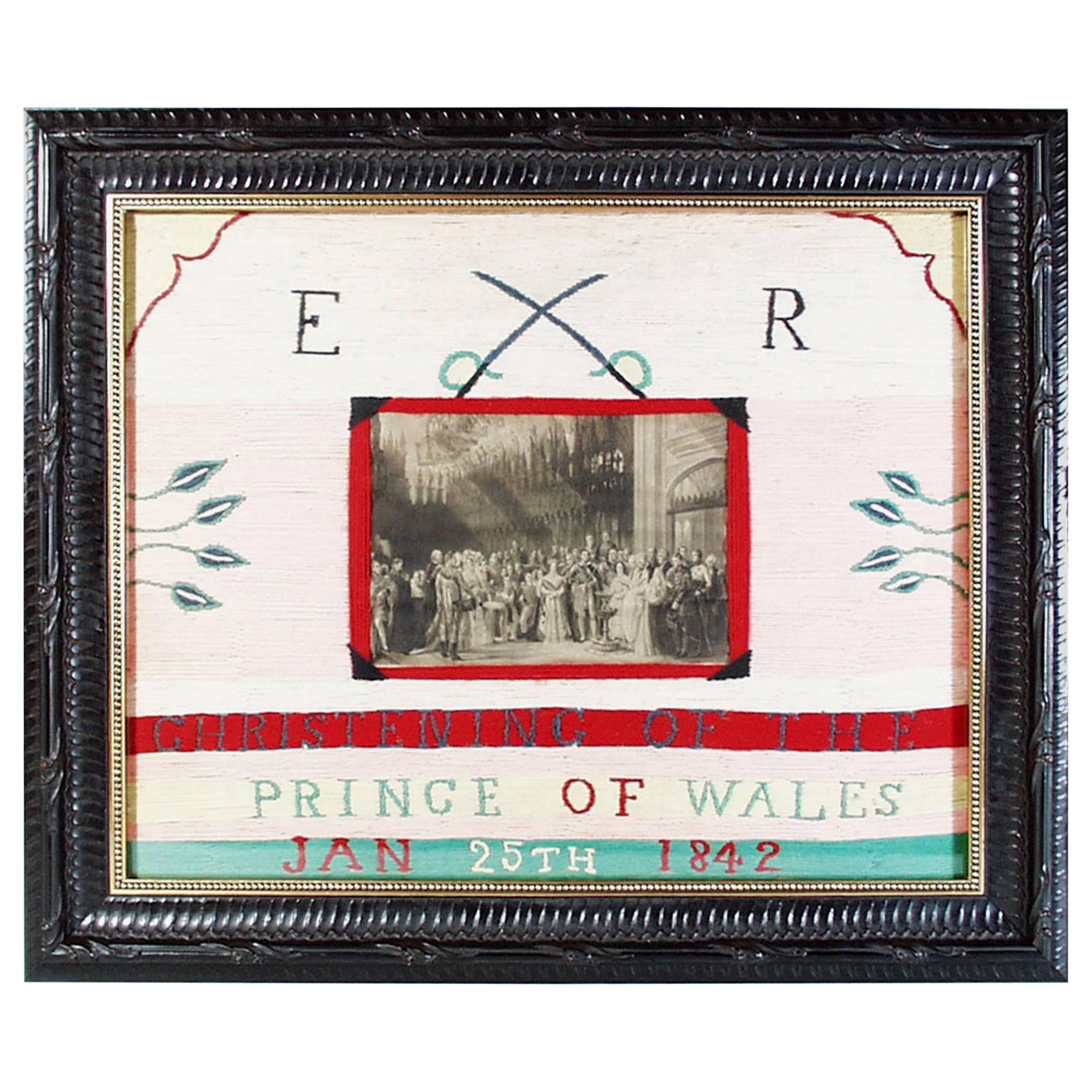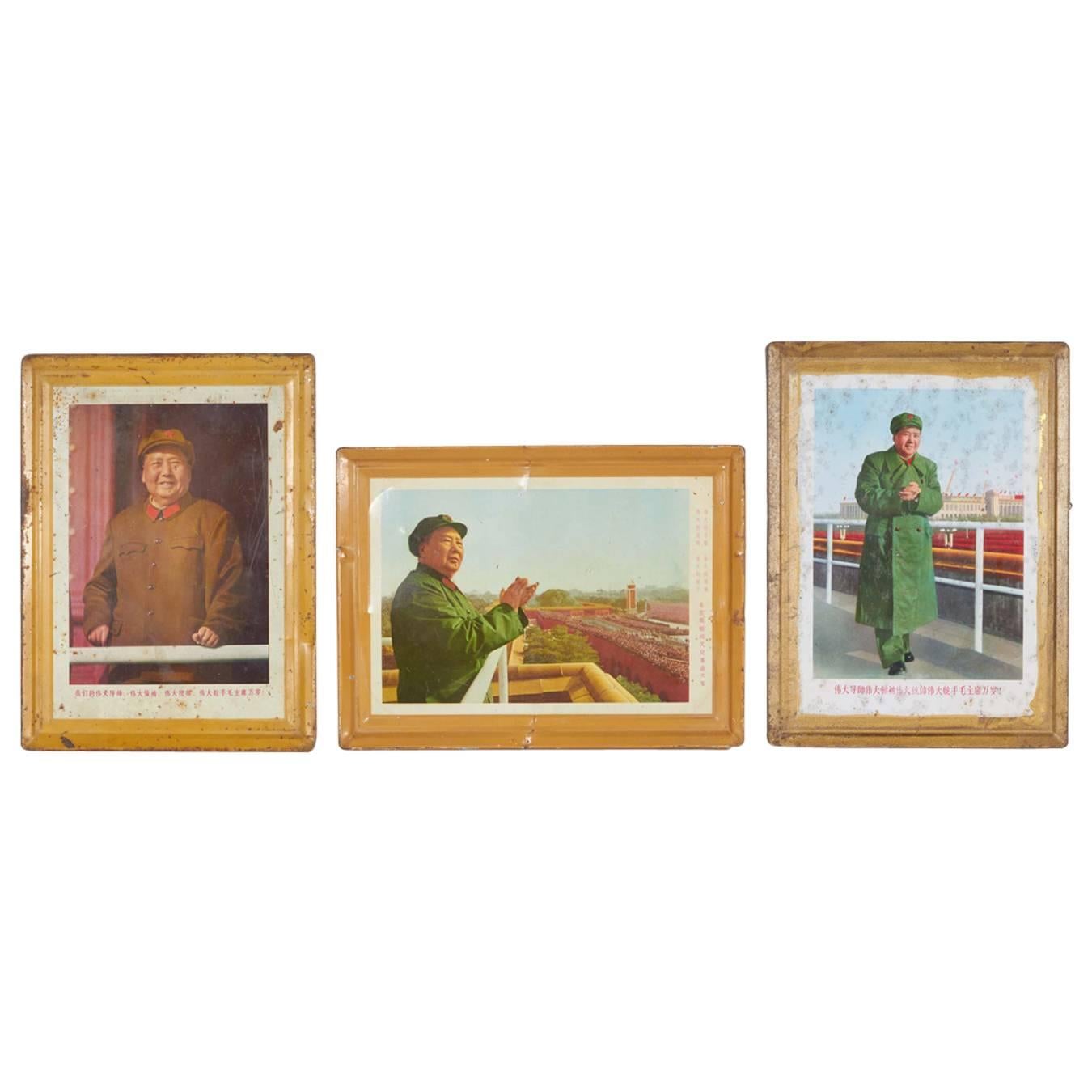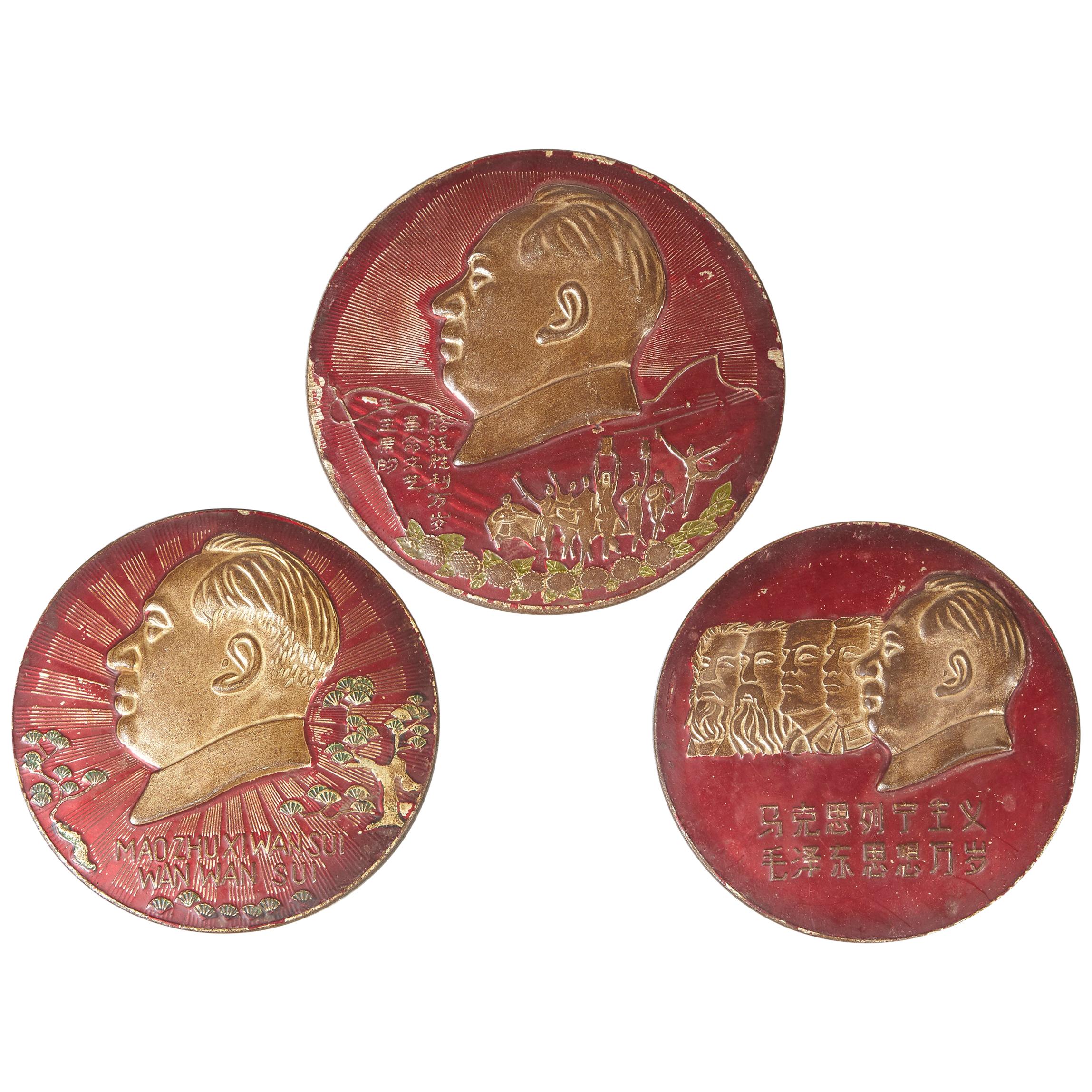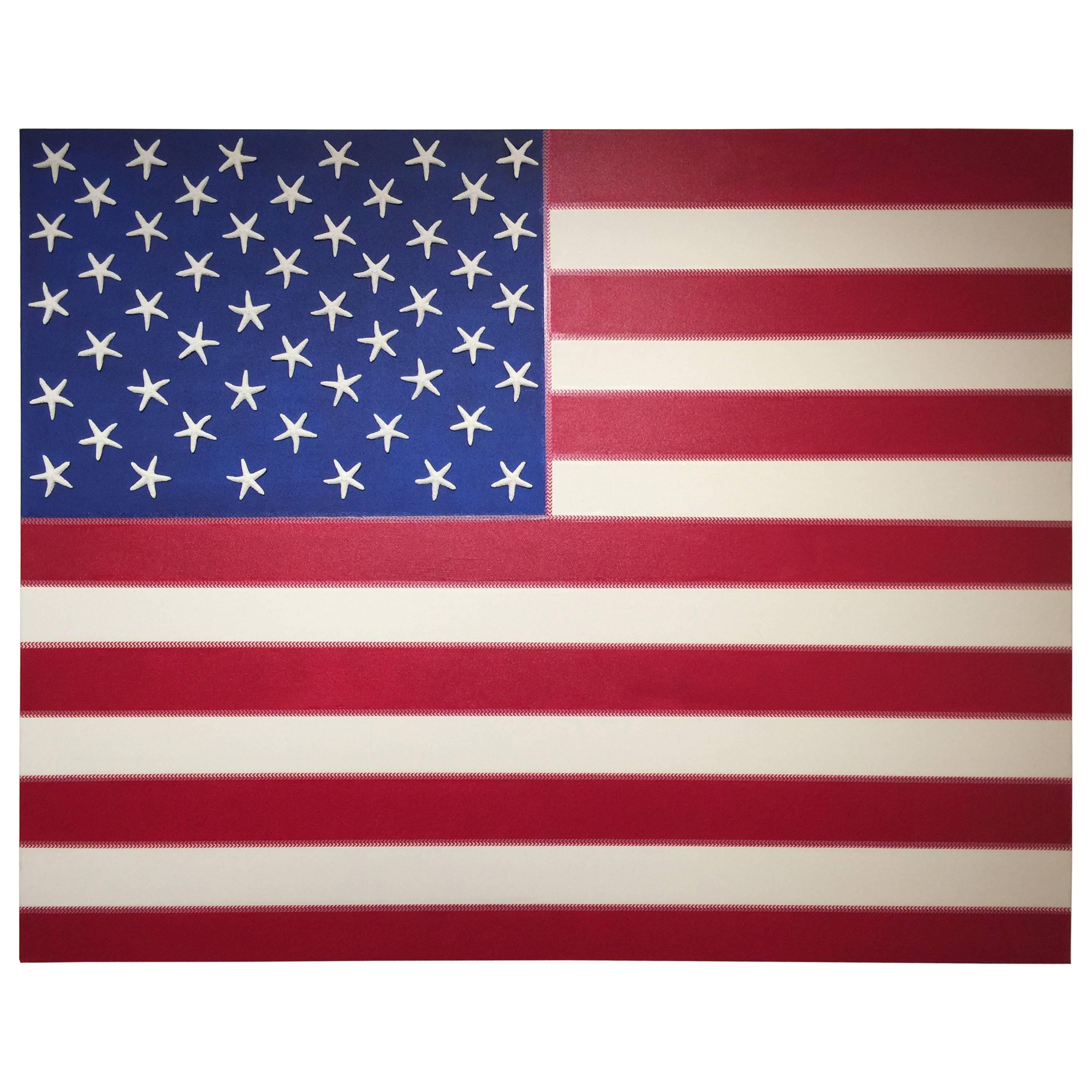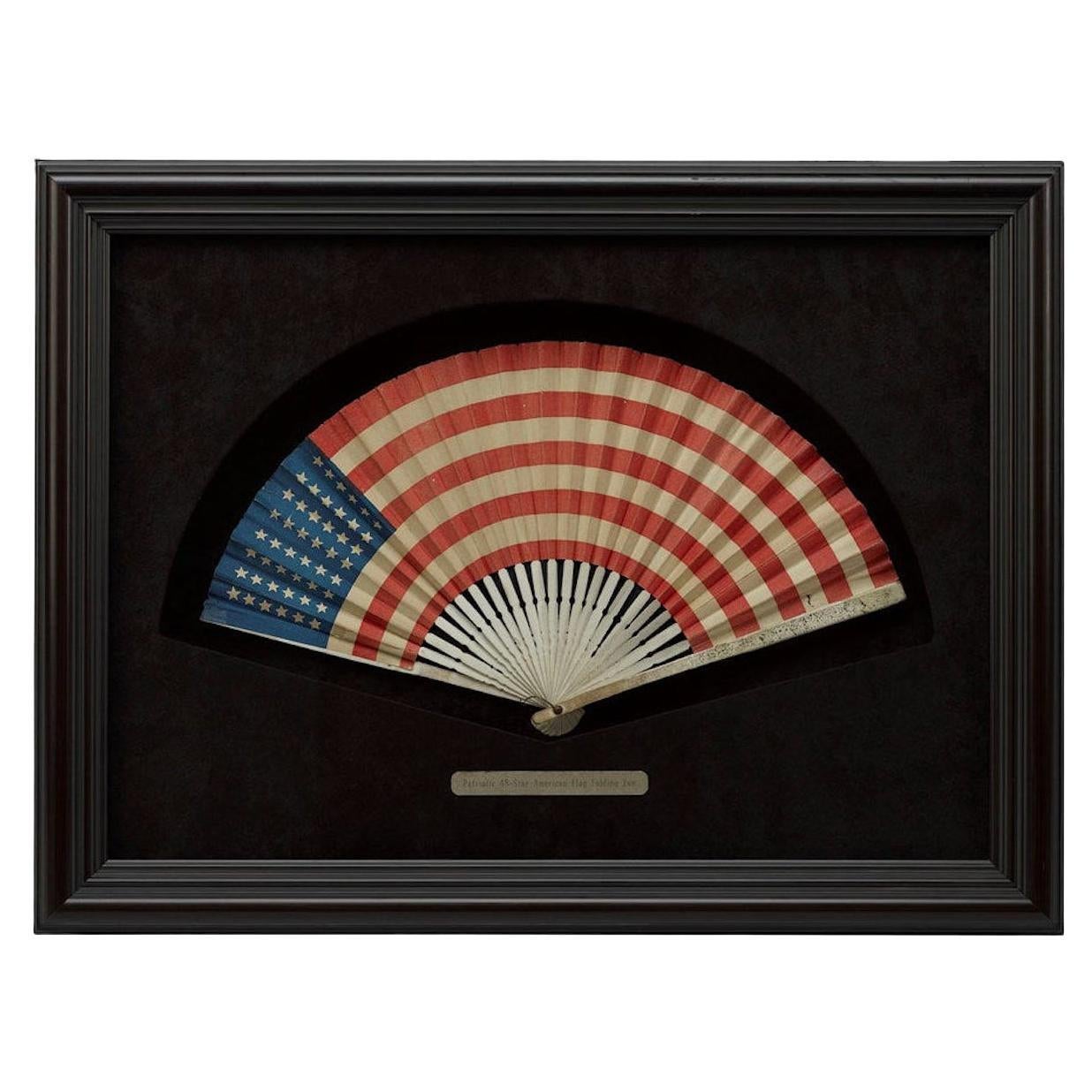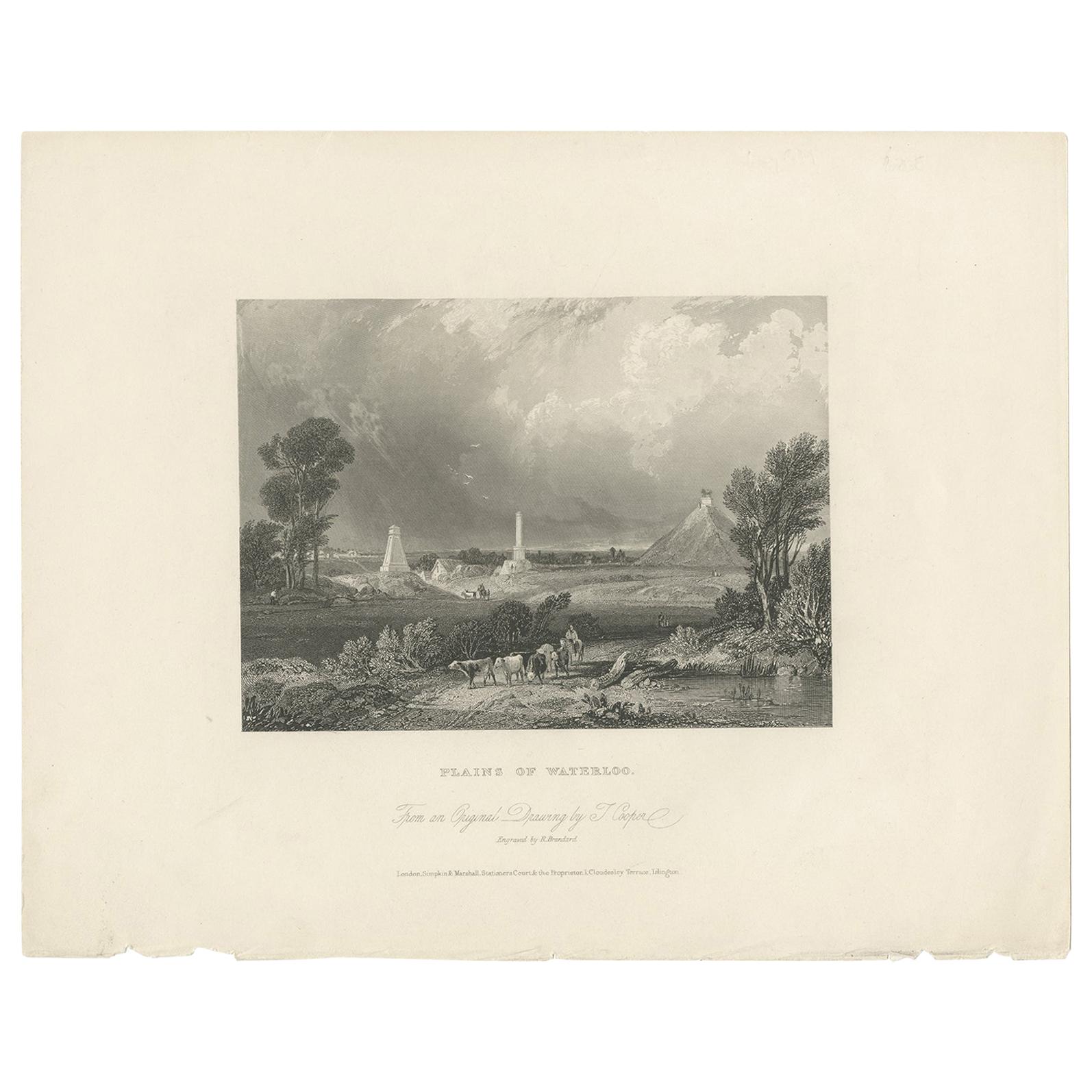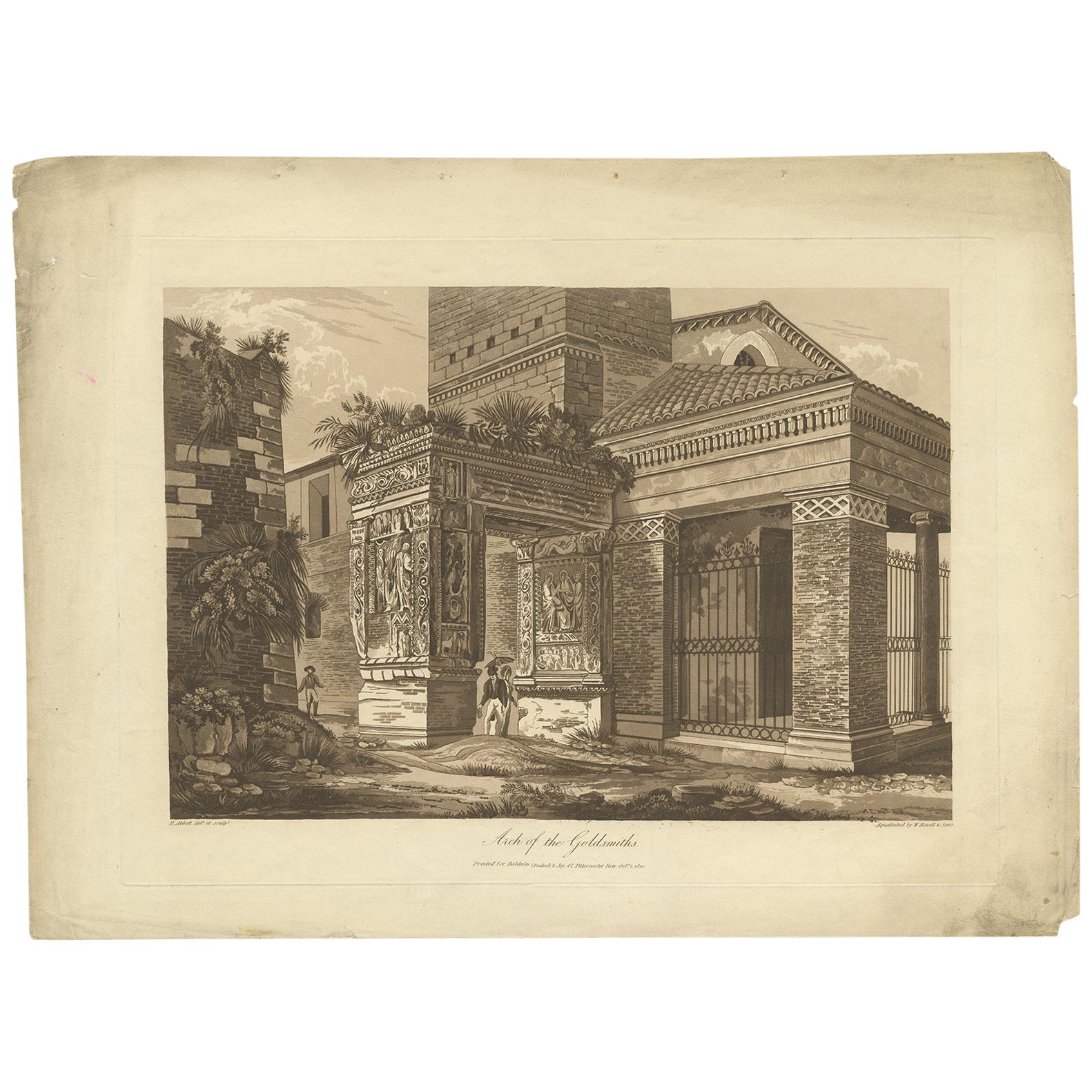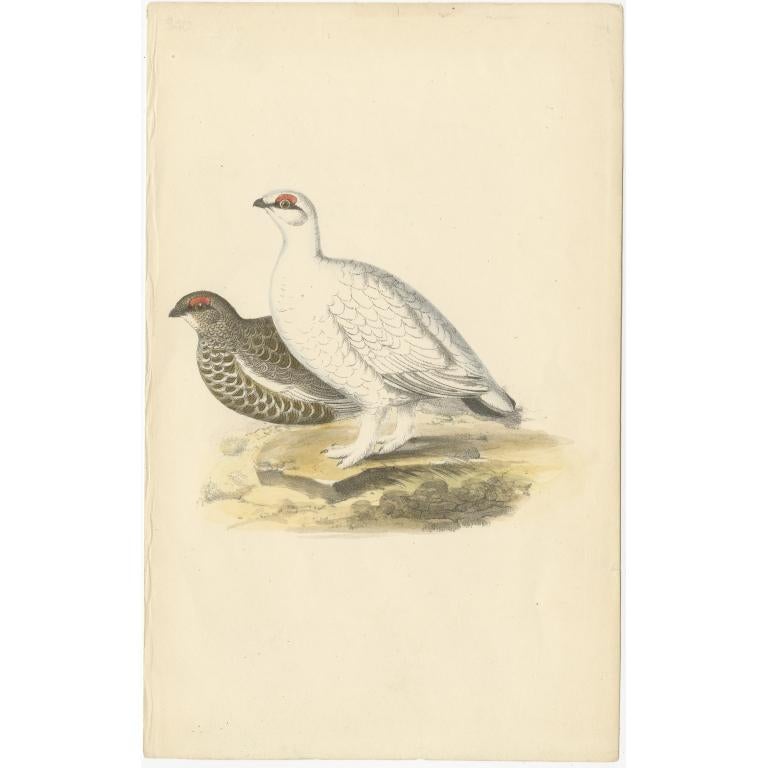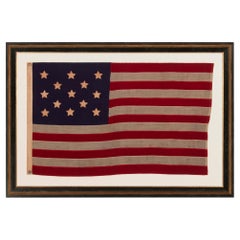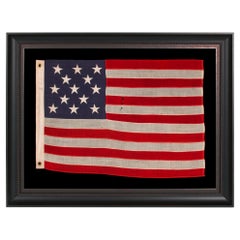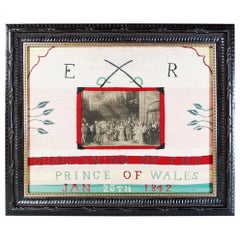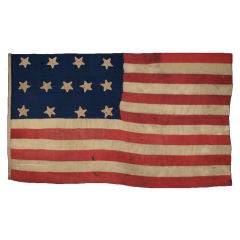
13 Star Flag Of The 1820-1840 Period Or Prior
View Similar Items
Want more images or videos?
Request additional images or videos from the seller
1 of 10
13 Star Flag Of The 1820-1840 Period Or Prior
About the Item
Among surviving antique American flags that date to the 19th century and prior, very few exist that pre-date the Civil War (1861-65). I often cite the number that fall into this bracket as being fewer than one-in-one-hundred. One-in-three-hundred is probably a reasonable estimate. Within this fractional percentage, far fewer pre-date 1840, and of those that actually do, some of these exceptionally rare survivors are simultaneously enormous and graphically plain. Made primarily for ships, they are too big to reasonably frame and display in even the largest of private homes.
This 13 star flag was made prior to the the 1840 benchmark, is more reasonable in scale and, at the same time, visually compelling. Arranged in the 4-5-4 pattern, the stars have arms that terminate in flattened points. This distinctive profile is shared with some of the earliest of known examples and, according to any number of historical records, the 4-5-4 arrangement would have been seen on a significant number of our nation's eldest flags. Note how the stars point in various directions on their vertical axis, which adds a nice folk quality to this beautiful early textile, as does the uneven spacing created by the justified rows in two different counts.
This 4-5-4 pattern flag formerly accompanied the "Easton Flag" at the Easton Public Library in Northumberland County, Pennsylvania. The Easton Flag is one of the most famous early examples that physically exists in present day America. Its imagery was basically a reversal of the Stars & Stripes. Instead of a blue canton with 13 white stars, resting on a field of 13 red and white stripes, the Easton flag has a canton made of 13 red and white stripes, resting on a wide field of solid blue, on which there are 13 stars, arranged in a circular pattern of 12 with a star in the very center.
Long rumored to be one of ancestors of the Stars & Stripes, local legend held that the Easton Flag was flown over the courthouse on July 8th of 1776, when the Declaration of Independence was read aloud on the courthouse steps by the county clerk. The Second Continental Congress did not adopt a national flag until almost a year later, on June 14th, 1777. This portion of the history of the Easton flag is disputed as merely myth by most flag historians, because there is no hard evidence that it existed in that period, but the remainder of the flag's story is better documented. On September 6th, 1814, the flag is known to have been presented by the 14-year-old daughter of a man named George Beidleman, to Captain Abraham Horn's local militia unit as they dispatched for service in the War of 1812. At the war's end the Company disbanded and returned home with the flag. In 1816, former members of Horn's Company, joined together with Captain Peter Nungesser's Company of Light Infantry, to form a new militia unit called the Easton Union Guards. In 1821, the decision was made to deposit the flag with the Easton Library Company for safe keeping in Library Hall on North Second Street, where it remains to this day (though in a new facility).
In June or July of 1945, The Easton Public Library contracted with the Smithsonian's famed flag restorer, Katharine Richey, who had performed the conservation on America's most famous surviving flag, the Star Spangled Banner. Richey was commissioned to conserve and restore both the Easton Flag and this very early 13 star flag in the 4-5-4 pattern, which was also apparently in the Library's possession. The flag was apparently on loan from the Northampton County Historical & Genealogical Society. The two flags were featured together in a July 3rd, 1945 article for a local newspaper, accompanied by a photo of Richey holding the 4-5-4 pattern flag with the help of librarian Richard D. Minnich. In the article, Richey pronounces both flags to positively date to the 18th century. A signed letter from Richey to Minnich, dated June 30, 1945, formerly states her opinion regarding the 4-5-4 example.
In 1961, the Northampton County Historical & Genealogical Society sold the 13 star, 4-5-4 pattern flag for the sum of $50, to a collector by the name of John Scheid [b. 05/31/17, d. 03/28/97], who had, in 1960, been selected as the first president of the Forks of the Delaware Historical Arms Society. The original receipt survives with the flag, as does the Richey's letter. 36 years later, in 1997, following Scheid's death, a New Jersey collector purchased the flag from the Scheid estate. The flag was taken to the Smithsonian, where it was examined by textile expert Katherine Dirks, who later led the project team that restored the Star Spangled banner. Dirks' formal, one-page report was regrettably lost, and her department at the National Museum of American History has since been closed, but her original, signed, summary letter to the collector survives. It states that "the flag appears to be from the early 19th century, rather than the 18th century", an opinion with which I personally agree. The collector fortunately recalls extensive verbal communication with Dirks, who found that one of the threads used in the construction was not commercially available in the United States until 1812. The thread was commercially available in England before that date. Because it was probably the most recently made fabric used in the construction of the flag, this thread establishes the earliest possible date that the flag could have been made.
The stars are made of cotton, hand-sewn, and single-appliquéd. This means that they were applied to one side of the canton, then the blue fabric was cut from behind each star, folded over and under-hemmed, so that one appliquéd star could be viewed on both sides of the flag. This was a common method of applying the stars during this period.
The canton and stripes of the flag are constructed of wool bunting with a coarse, homespun weave and with significant irregularity in the width of the strands. The wool is an early variety, with the appropriate characteristics that I have found to be indicative of the period between approximately 1820 and 1840, though it could be slightly earlier. The canton is made up of two laterally joined, 18-inch wide lengths of fabric. 18 inches is a standard loom width for wool bunting made throughout the 19th century and prior.
The hand-sewn hoist binding is made of sailcloth canvas. At the top and bottom of this are hand-sewn, whip-stitched grommets. The word "Armory" was written along the obverse of the hoist with a dip pen, near the bottom, in a 19th century hand. Although the flag is very small in size for garrison use, it may have been sufficient for a small barracks or it may have served as one of several flags in the stores at an armory, available for whatever use the ranking officer intended. It may also have seen use at sea and was afterwards put into storage. Whatever the case may be, the flag experienced losses at the fly end and was clearly flown for an extended period. It was longer originally, yet because there were no official proportions for the American national flag until the 20th century, its original length cannot be not known with certainty. What is known is that American flags were often made in an elongated format for use on ships, so that they could be folded back and hemmed as they experienced loss from wind damage.
At the top of the hoist, two groups of numbers are written in a more modern hand. These are inventory codes and were probably used at the Easton Public Library or the Historical Society.
Why 13 Stars?
The U.S. Navy used the 13 star count on small boats, not only in the 18th century, but throughout much or all of the 19th century, particularly the second half. Ship captains were paranoid about the ability of foreign ships to recognize the flag on the open seas. On smaller scale flags [most of which seem rather huge in today's world], the ability discern individual stars at a distance, through a spyglass, was a serious concern. Keeping the count at 13 for the flags used on maintained better visibility. In my experience, the use of 13 stars for small naval flags during this early period was not consistent and the same seems to have been true for at least some flags used on land. Some documented examples survive that have the full complement of stars and some have 13. The use of 13 became more consistent by the military at sea as time passed. The practice theoretically ended in 1916, following an executive order from then-President Woodrow Wilson, though old military traditions die hard and, according to the late Smithsonian flag expert Grace Rogers Cooper, Wilson’s order did not completely dispel the presence of 13 star flags on U.S. Navy craft.
Two thirds of the top two stripes of the flag were purposely cut from the fly end. This is clear evidence of "souveniring," a practice carried out by military men following a either significant term of service or a notable engagement. Pieces of the flag were thus clipped and taken home as mementos. The July 3rd, 1945 newspaper article states that restorer Katharine Richey felt that the "dark brown splotches" were blood. Although these have not been tested, Richey by this time reports to have conserved almost 5,000 flags, including 200 for the Gothic Chapel at West Point and many for the State of Pennsylvania.
In summary, this exceptional 13 star flag, dating to the period between 1820 and the 1830's, and potentially earlier, is a steadfast survivor among the oldest known American national flags. With an interesting, documented history in its association with Easton, Pennsylvania and the Easton Flag, and one of the most interesting personalities in the preservation and study of historic flags, it has great folk qualities in its squared-off stars that point in various directions an in its handmade construction with a much-worn appearance. Together these factors constitute a fantastic early 19th century example.
Condition: In addition to the above notes on souveniring and possible blood stains, there are significant tears and losses throughout, and the binding stitches at the fly end are absent, all of which serve as evidence that the flag experienced natural loss during its course of use. Fabrics of similar coloration were placed behind all of the above affected areas during the mounting process. The foxing and staining throughout is expected. Many of my clients prefer flags to show their age and history of use. Further, the great rarity of 1840 and prior examples warrants most any condition.
Mounting & Conservation: Katharine Richey's method of flag preservation, devised by her mother, would have been a destructive process to this flag if it were not made of sound materials and if we had not removed her work. We removed thousands of stitches and her linen backing. The Smithsonian undertook the same task with the Star Spangled Banner.
Following the reversal of Richey's work, the flag was hand-stitched to 100% silk taffeta for support throughout the seams and the star field. It was then hand-stitched to 100% cotton, black in color, which was washed to reduce excess dye. An acid-free agent was added to the wash and the fabric was heat-treated for the same purpose. This process has prepared the flag for framing.
- Place of Origin:
- Period:
- Date of Manufacture:1820-1840
- Condition:See Item Descriptions.
- Seller Location:York County, PA
- Reference Number:Seller: 13j-10541stDibs: U1112128497500
About the Seller
5.0
Recognized Seller
These prestigious sellers are industry leaders and represent the highest echelon for item quality and design.
Established in 1991
1stDibs seller since 2008
61 sales on 1stDibs
Typical response time: 10 hours
More From This SellerView All
- 13 Star Antique American Flag , Ca 1890-1899Located in York County, PA13 STARS WITH SHORT, CONICAL ARMS ON A SMALL SCALE, ANTIQUE AMERICAN FLAG MADE DURING THE LAST DECADE F THE 19TH CENTURY; POSSIBLY OF PHILADELPHIA ORIGIN; FORMERLY IN THE COLLECTION ...Category
Antique 1890s American Political and Patriotic Memorabilia
MaterialsWool
Price Upon Request - 13 Star Antique American Flag, ca 1895-1926Located in York County, PA13 STAR ANTIQUE AMERICAN FLAG WITH A 3-2-3-2-3 CONFIGURATION OF STARS ON AN INDIGO CANTON, SQUARISH PROPORTIONS, AND A BEAUTIFUL OVERALL PRESENTATION, MADE circa 1895-1926 This 13 s...Category
Antique Late 19th Century American Political and Patriotic Memorabilia
MaterialsWool
Price Upon Request - 13 Star Antique American Flag in the Betsy Ross Pattern, ca 1861-1865Located in York County, PA13 star antique American flag in the Betsy Ross pattern, one of just three examples that I have encountered that pre-date the 1890’s; an extraordinary find, civil war period (1861-1865) or just after, extremely large among its counterparts of all periods in this design: Exceptional, early, American national flag, with 13 stars arranged in the circular wreath pattern most often attributed to Betsy Ross. Since there was no official configuration for the stars of the American flag until 1912, when our nation received its 47th and 48th states, the design, before that time, was left to the whims of the maker. This led to an almost unimaginable spectrum of star arrangements on the American flag during the 18th and 19th centuries. Even within the 13 star count, alone, there are at least 80 known patterns—more than the average person would even think possible. 13 star flags have been made throughout American history, from at least June 14th, 1777, when the first Flag Act was passed by Congress, until the present. They have been continuously produced for reasons both patriotic and utilitarian. Because this was the original number of stars on the American flag, representing the 13 colonies, it was appropriate for any device made in conjunction with celebrations or notions of American independence. 13 star flags were thus displayed at patriotic events, including, but certainly not limited to, such occasions as Lafayette’s final visit, in 1825-26, the nation’s centennial in 1876, and longstanding celebrations of Independence Day. From at least 1840 onward, 13 star flags were produced for presidential campaigns, drawing a parallel between the past and present struggles for freedom, and were carried by soldiers, during the Mexican and Civil Wars, for the same purpose. Throughout history, and even today, they are boldly displayed at every presidential inauguration. 13 star flags were flown by American ships both private and federal. The U.S. Navy used 13 stars on the ensigns made for small boats, because they wished the stars to be more easily discernable at a distance. Private ships often copied Navy practice, and when commercial flag makers first began to produce flags with pieced-and-sewn construction, in small sizes, in large quantity, they frequently employed the 13 star count. Flags in the Betsy Ross design are widely admired, due to the longstanding popularity of the Ross family myth. While many Americans learned in grammar school that Betsy Ross made and designed our first flag, and that the stars appeared in a circular fashion, there is, unfortunately, no way to prove the claim. No colonial examples have survived with this pattern of stars. In fact, while arranging the stars in a single circle seems quite logical, among the various choices that might come to mind, early American flags with this star pattern are curiously absent. One of the interesting misconceptions about 13 star flags is that the Betsy Ross pattern, even if not the original design, must have been common in early America. Logic would suggest this, given the frequency with which it appears in modern times, but this isn’t actually the case. In fact, the pattern is seldom encountered anywhere until much later. In more than 30 years of buying and selling early Americana, and over 20 years of extensive focus on the American flag specifically, through aggressively buying, researching, evaluating, restoring, and curating exhibitions, I have thus far encountered just three examples of Betsy Ross pattern flags that I can confidently date prior to the 1890's. No one knows what the first flag looked like. While there is no precise reason that the Betsy Ross design could not have been the first, one of the best arguments against it, is illustrated by the simple fact that so many 13 star flags exist without it. If the Ross configuration was the original, it stands to reason that the pattern would have been reproduced with at least some degree of frequency. Research conducted by the National Museum of American History notes that the story of Betsy Ross making the very first American flag for General George Washington, in the company of George Ross and Robert Morris, entered into American consciousness about the time of the 1876 centennial. The tale was immensely popular among an American public eager for stories about the Revolution and its heroes. The first documentation of it appeared shortly beforehand, in 1870, in a paper written by Betsy’s grandson, William Canby, for the Pennsylvania Historical Society. At the time, Canby made no mention of how the flag was designed, save for the fact that it had 5-pointed stars, per his grandmother’s suggestion. Because no earlier documentation supports the story, most flag scholars feel it was a grand hoax, fabricated by Canby for his own interests. Nothing survives in the collective writings of the three men, for example, nor in records of their words and deeds, which are fairly extensive. As with most things, reality is perhaps somewhere in the middle ground, with some of the details based on fact and some on fiction, made up, misinterpreted, or imagined from family accounts. The first time that a star configuration gets attached to the Ross story appears to have occurred during the last decade of the 19th century. In 1892, Charles Weisgerber painted a nine-by-twelve-foot rendition of the fabled meeting between Betsy and George Washington, in which there is a flag with a circular wreath. Shortly afterwards, in 1898, Betsy’s granddaughter and great-granddaughter began to make flags in the East Wing of Independence Hall in Philadelphia, selling them to tourists while disseminating the family folk tale. In that same year, Weisgerber and a “group of concerned citizens” sought to preserve Betsy’s former Philadelphia residence at 239 Arch Street, where she lived at the time the flag would have been sewed. Weisgerber moved his family into the house and immediately opened to the public the room in which Betsy was said to have worked her magic. Ten-cent memberships were sold to fund renovations and donors received a small calendar, to which a cotton 13 star Betsy Ross pattern parade flag was affixed. The effects of these events caused the Ross legend to stick and the story, with the corresponding flag design, has appeared ever since in more places than one could ever hope to count. The stars of this particular flag are made of cotton, hand-sewn, and double-appliquéd (applied to both sides). The canton and stripes of the flag are made of wool bunting that has been pieced and joined with treadle stitching. There is a sailcloth canvas binding along the hoist, with two brass grommets, one each at the extreme top and bottom. Along this, on the obverse, near the bottom, are two, unusual characters, embroidered with brown thread. These may be letter “I’s,” possibly forming a the Roman Numeral “II.” They are followed by an inscription, in blue ink, that appears to read “A. N. Smith.” The first character is stylized, and may alternatively be a “D,” “H,” or perhaps a “J.” Note how the binding is extended beyond the top and bottom-most points. Though quite unusual, this is sometimes encountered in early examples. The folding of the wool bunting back onto itself, with the binding stitched so that part of the fold is exposed, tends to be an early characteristic. Common in Civil war flags...Category
Antique 1860s American Political and Patriotic Memorabilia
MaterialsCotton
Price Upon Request - 13 Star, Betsy Ross Pattern Flag, Made by the Annin Company, ca 1955-1965Located in York County, PA13 STARS IN THE BETSY ROSS PATTERN, ON A VINTAGE AMERICAN FLAG, MADE BY THE ANNIN COMPANY OF NEW YORK & NEW JERSEY, circa 1955 - 1965 13 star American national flag, made entirely of cotton by the Annin Company of New York & New Jersey, in the period between approximately 1955-1965. The stars are arranged in the circular wreath pattern most often associated with Betsy Ross. Flags in this design are widely admired, due to the longstanding popularity of the Ross family myth. While many Americans were taught in grammar school that this was what our first flag looked like, there is, unfortunately, no way to substantiate the claim, and no colonial flags...Category
Late 20th Century American Political and Patriotic Memorabilia
MaterialsCotton
- 13 Star American Flag with Hand-Sewn Stars in the 3rd Maryland PatternLocated in York County, PA13 hand sewn stars in a circular version of what is known as the 3rd Maryland pattern, with an especially large center star, a flag with especially tiny scale among those with pieced-and-sewn construction, exceptionally rare, made circa 1890: 13 star flags have been flown throughout our nation’s history for a variety of purposes. They were hoisted at patriotic events, including Lafayette’s visit in 1824-25, the celebration of the centennial of American independence in 1876, and the sesquicentennial in 1926. They were displayed during the Civil War, to reference past struggles for American liberty and victory over oppression, and were used by 19th century politicians while campaigning for the same reason. As the number of stars grew with the addition of new states, it became more and more difficult to fit their full complement on a small flag. The stars would, by necessity, have to become smaller, which made it more and more difficult to view them from a distance as individual objects. The fear was that too many of them close together would become as one white mass and distort the ability to identify American ships on the open seas. Keeping the count low allowed for better visibility. For this reason the U.S. Navy flew 13 star flags on small boats. Some private ship owners mirrored this practice and flew 13 star flags during the same period as the Navy. Flag experts disagree about the precisely when the Navy began to revert to 13 stars and other low counts. Some feel that the use of 13 star flags never stopped, which seems to be supported by depictions of ships in period artwork. This was, of course, the original number of stars on the first American national flag, by way of the First Flag Act of 1777, and equal to the number of original colonies that became states. Any American flag that has previously been official remains so according to the flag acts, so it remains perfectly acceptable to fly 13 star flags today by way of congressional law. Since there was no official star configuration until the 20th century (1912 specifically, beginning with the 48 star count), the stars on 13 star flags may appear in any one of a host of configurations. Some of these are more rare and desirable than others. The stars of this particular flag are arranged in what has come to be known as the "3rd Maryland Pattern." This configuration, whether oval or circular, is appreciated both for its visual appeal and the scarcity of its use. a circular wreath of 12 with a single star in the center. The name comes from a flag that resides at the Maryland State Capitol in Annapolis, long thought to have been present with General Daniel Morgan at the Battle of Cowpens in 1781. According to legend, the flag was supposed to have been carried by Color Sergeant William Batchelor of the 3rd Maryland Light Infantry and was donated to the State of Maryland by Batchelor's descendants. The story was disproved in the 1970's, however, following an examination by the late flag expert Grace Rogers Cooper of the Smithsonian, who discovered that the Cowpens flag was, at the earliest, of Mexican War...Category
Antique 1890s American Political and Patriotic Memorabilia
MaterialsWool
Price Upon Request - Hand-Sewn 13 Star American Flag, Signed Grunfild, ca 1861-1877Located in York County, PAENTIRELY HAND-SEWN ANTIQUE AMERICAN FLAG OF THE CIVIL WAR ERA, WITH 13 SINGLE-APPLIQUÉD STARS IN A 3-2-3-2-3 CONFIGURATION, IN A GREAT, SMALL SCALE AMONG ITS COUNTERPARTS, PROBABLY MADE IN NEW YORK CITY, SIGNED “GRÜNFILD” 13 star flags have been flown throughout our nation’s history for a variety of purposes. They were hoisted at patriotic events, including Lafayette’s final visit in 1824-25, the celebration of the centennial of American independence in 1876, and the sesquicentennial in 1926. They were displayed during the Civil War, to reference past struggles for American liberty and victory over oppression, and were used by 19th century politicians while campaigning for the same reason. As the number of stars grew with the addition of new states, it became more and more difficult to fit their full complement on a small flag. The stars would, by necessity, have to become smaller, which made it more and more difficult to view them from a distance as individual objects. The fear was that too many of them close together would become as one white mass and distort the ability to identify American ships on the open seas. Keeping the count low allowed for better visibility. For this reason the U.S. Navy flew 13 star flags on small boats. Some private ship owners mirrored this practice and flew 13 star flags during the same period as the Navy. Flag experts disagree about precisely when the Navy began to revert to 13 stars and other low counts. Some feel that the use of 13 star flags never stopped, which seems to be supported by depictions of ships in period artwork. This was, of course, the original number of stars on the first American national flag, by way of the First Flag Act of 1777, and equal to the number of original colonies that became states. Since there was no official star configuration until the 20th century (1912 specifically, beginning with the 48 star count), the stars on 13 star flags may appear in any one of a host of configurations. Made during the Civil War era, or shortly thereafter, the stars of this particular 13 star flag are arranged in a 3-2-3-2-3 pattern of lineal rows. This configuration appears to have been adopted by the Navy sometime toward war’s end, probably between 1864 and 1865. Afterwards it becomes the most common design across all known styles, for the balance of the 19th century through the first quarter of the 20th. Entirely hand-sewn, the stripes and canton of the flag are made of wool bunting. Note in particular the square profile of the canton, which makes it visually different from modern flags. The stars are made of cotton and are single-appliquéd. This means that they were applied to one side of the canton, then the blue fabric was cut from behind each star, folded over, and under-hemmed, so that one star could be viewed on both sides. I always find single-appliquéd stars more interesting, not only because they are evidence of a more difficult level of seam-work and stitching, but also because they are more visually intriguing. The two visible rows of hand-stitching emphasize their hand-sewn construction. This is one reason why single-appliquéd stars appeal to connoisseurs of early American textiles. While some flag enthusiasts have pointed to this as a means of conserving fabric, not having to cut and sew another star to the opposite side, others suggest that the real purpose was to make the flag lighter in weight. I believe it to have been a byproduct of both objectives. A length of faded, red, herringbone, twill cotton tape was stitched along the hoist end for reinforcement, in lieu of a more formal binding. To this, six lengths of cotton knit shoelace were added (one now absent) as a means of affixing the flag to a staff. This is generally the accepted method for a flag that is to be hand-carried. The cloth tape and ties both add substantially to the flag’s visual presentation. The name “Grünfild” was at some point hand-inscribed beneath the canton. It was common to mark flags in this fashion, during the 19th and early 20th centuries, to indicate ownership. An unusual name in America at this time, I believe that this likely belonged to the only man by this name that is recording as having served during the Civil War. Born around 1843, Morris Grünfild [a.k.a. Grünfield / Greenfield / Grünfildt] emigrated to the United States from Eastern Europe in 1854. A merchant tailor, who I believe may have been of Russian Jewish descent, he records himself as having been born in “Poland / Rus,” but may have moved to Austria in the interim, before traveling to the States. In May of 1861, Grünfild enlisted with the 31st New York Volunteer Infantry, at the rank of Private, in New York City, and was assigned to “C” Company. He served two years, mustering out in New York on June 4th, 1863. Around 1877, Grünfild joined Frank Head Post #16 of the New York State Grand Army of the Republic. The GAR was the primary veteran’s organization for the Union Army. He married a Russian woman from Philadelphia, had many children, and continued to work as a tailor into the 20th century, possibly selling both his services and clothes. Presuming that it was this Morris Grünfild who owned and marked the flag, it is hard to be sure just how he came into possession of it. The construction is actually typical of flags produced in New York, during this time frame and after, by the Annin Company. Known for single-appliqued stars, and for hand-sewing the stripes of smaller flags in particular, as well as for simply producing more, small, sewn flags than their competitors, the flag closely approximates signed, Annin-made examples that I have previously owned. It may, of course, be that Grünfild acquired the necessary bunting at the wharf and sewed the flag in the same fashion as Annin, but I don’t think so. I do, however, believe that it was he who added the herringbone tape and shoelace ties to a flag probably of Annin manufacture. It’s possible that the 31st NY Regiment used the flag as a flank marker or as camp colors. Though a little large in scale for either when compared to military regulations, the flag is small enough to have served effectively in either function. This unit appears not to have turned any colors in to the state at the war’s end, so likely they were taken home. The role that Grünfild played as a private in C Company is unknown. As a tailor, it’s conceivable that he may have played a role in the care or upkeep of flags, but no further information is available. The 31st NY was a very active unit. Recruited from Williamsburg (just over the Brooklyn Bridge) and Manhattan, it had several nicknames, including the “Montezuma Regiment,” “Baxter Light...Category
Antique Late 19th Century American Political and Patriotic Memorabilia
MaterialsCotton
Price Upon Request
You May Also Like
- Christening of the Prince of Wales Woolwork Picture, Dated 1842Located in Downingtown, PAEnglish Royal Woolwork Picture, Titled E R/ Christening of the/Prince of Wales/Jan 25th 1842. A rare woolwork picture in bands of white, pink, red and green centered with a black and white picture...Category
Antique Mid-19th Century English Folk Art Decorative Art
MaterialsWool
- Set of Mao Cultural Revolution Portraits on TinLocated in New York, NYA set of three small striking Mao cultural revolution portraits on tin. Great historical pieces, China, circa 1960s. P394a.Category
Vintage 1960s Chinese Decorative Art
MaterialsTin
- Three Embossed Metal Cultural Revolution Plaques with Images of MaoLocated in New York, NYThree cultural revolution period embossed metal plaques, each with the image of Chairman Mao, one plaque also including images of the leaders of Russian communism. Priced and sold ...Category
Late 20th Century Chinese Decorative Art
MaterialsMetal
- J. WOHNSEIDLER American Flag No. 1, 2017 Acrylic on CanvasLocated in New York, NYAmerican Flag No. 1 by J. Wohnseidler. Arcylic on canvas with hand-applied starfish. Unframed. Signed/titled/dated by artist on back. Measures: 48 inches L x 36 inches H x 1.5 inches D.Category
2010s American Contemporary Art
MaterialsCanvas, Acrylic
- Patriotic 48-Star American Flag Folding FanLocated in Colorado Springs, COPresented is a printed folding fan featuring the American Flag, which dates to the early 20th century. With 48 printed stars on the fan’s canton, the fan celebrates New Mexico and Arizona statehood. The fan’s design is completed with 13 alternating red and white stripes across its white sticks and guard. The 48-star flag had a fly date of 47 years, from July 4, 1912 to July 3, 1958. Prior to the introduction of the 48-star flag with the admission of New Mexico and Arizona to the Union in 1912, no legislation existed regarding the official proportions, sizes, and pattern for stars on the American flag. As a result, many Americans designed the starry canton of their homemade flags to their own whim, in medallion, spiral, and flower star configurations. Coinciding with the introduction of the 48 star flag in 1912, President William Howard Taft...Category
Early 20th Century Decorative Art
MaterialsPaper
- Prior Avertising Sign 1924Located in Meulebeke, BEOld Italian advertising for cigar brand "Prior" sign in tinplate. Made by S.A.G. De-Andries Sampierdarena. Dated 1924.Category
Vintage 1920s Italian Art Deco Posters
MaterialsTin
Recently Viewed
View AllMore Ways To Browse
13 Star Flag
Antique 13 Star Flag
Antique Bunting Flags
Naval Flags
Mother Daughter By The Sea
Light Up Sign Folk
Flag Hard
30 Flag
Pennsylvania Flag
Sea Captains 19th
White Chapel Antiques
Dior Taffeta
50 American Flag
Silk Banner
Antique Felt Textile
Letter Scales
United States Declaration Of Independence
Historic Memorabilia

